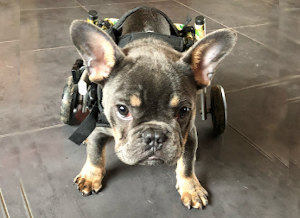- September 6, 2023
What You Need to Know About Puppy Mobility Loss

Usually, when people discuss mobility aids like dog wheelchairs, they are referring to older dogs. However, certain conditions can cause paralysis in dogs from birth, necessitating the use of a wheelchair from puppyhood to senior years. It’s not just old age that can lead to mobility issues.
Can a Puppy Wheelchair Help a Young Dog?

For growing pups that have difficulty walking or standing on their own, a puppy wheelchair is an ideal mobility solution. The younger a dog is, the more likely it is that their body will grow and change as they mature, which means they need a cart that will grow with them.
An adjustable wheelchair is the best option for a paralyzed puppy. With easy adjustments in height, length, and width, the Walkin’ Wheels dog wheelchair can grow with a puppy. A wheelchair expert can help you select a wheelchair size that will grow with your pup the longest.
Conditions that Cause Mobility Loss in Puppies
There are a wide range of reasons why a puppy may have difficulty walking, from injury, an incident at birth, or a genetic cause. Here are a few of the more common reasons why a young dog may experience mobility loss:
Cerebellar Hypoplasia

Cerebellar Hypoplasia is a disease that affects dogs’ balance, posture, and coordination. The Cerebellum is underdeveloped in pets with cerebella hypoplasia, the portion of the brain that is responsible for maintaining motor impulses.
Dogs with cerebellar hypoplasia (CH) typically exhibit irregular balance and difficulty placing their paws. Their gait may resemble marching and appear unsteady. CH puppies may also experience involuntary head tremors and shaking. To stand upright and move without falling over, puppies with Cerebellar Hypoplasia need a full-support wheelchair with wheels in the front and back for optimal support.
Idiopathic Epilepsy in Puppies
Idiopathic epilepsy is a condition where your dog has abnormal brain function that causes seizures. While the cause is unknown, it is very likely to be a genetic trait, as pure-breed dogs are more prone to seizure activity.
Epileptic puppies will typically have their first seizure within the first year of their life and may continue seizure activity throughout, or it may be a one-time occurrence. Seizures are usually unpredictable, and depending on the occurrence, some dogs may need support or have trauma to the brain stem that leaves them paralyzed.
Spinal and Vertebral Birth Defects
These defects can cause malformations of the vertebra and cause damage to the spinal cord. The trauma to the spinal cord can cause mobility struggles and paralysis.
These spinal malformations are obvious from birth and easily visible. Most often showing in the curvature of the spine. Scoliosis is one of the more common spinal birth defects that affect puppies.
Congenital Hydrocephalus
Hydrocephalus is a rare disorder in dogs. Hydrocephalus literally means “water on the brain,” but the fluid that builds up is cerebral spinal fluid (CSF). In hydrocephalus, this fluid is unable to drain away properly and increases pressure on the brain. Congenital hydrocephalus is believed to be due to a problem during fetal growth and is seen in puppies. Hydrocephalus can cause spastic or high-step walking and seizures, which will cause a decrease in mobility.
Dancing Doberman disease
Named after the breed it typically affects, it is a neural disorder that affects the gastrocnemius muscle in Dobermans. At around 6 or 7 months, their rear leg will begin to flex when they stand. Eventually, this will begin in the other hind leg.
As the muscles flex, it looks like the pup is dancing, hence the name! Dancing Doberman disease progresses to rear leg weakness and muscle atrophy over a few years.
Wobblers Disease
Puppy Wobbler Syndrome commonly affects large and giant breed dogs. Caused by a constellation of abnormalities in the vertebrae and soft tissues of the neck that cause spinal cord compression.
The symptoms of Wobblers are an unsteady gait that slowly gets worse. Typically, the wobbly gait starts in the hind limbs but will also affect the front limbs.
This list is not exhaustive of conditions puppies can have that cause mobility problems. If you believe your puppy isn’t moving as it should, please contact your veterinarian.
Helping a Puppy with Mobility Issues
Early intervention is important for young dogs with mobility problems. In the early days, every day matters when it comes to a puppy’s development. Work with a veterinarian and rehab specialist to help the puppy build up its strength, and introduce a wheelchair when you can. It’s incredibly important for young puppies to be as active as they can from the very beginning.
Related Articles:
Tags
What do you think?
Related Articles

New Puppy Checklist: Gear You’ll Need for Your New Dog
Getting a new puppy is really exciting, but before you welcome them home, it’s important to prepare your space for them. Since puppies need a

How Big Do Mini Poodles Get? Vet Reviewed Average Weight & Growth Chart – Dogster
The information is current and up-to-date in accordance with the latest veterinarian research. Learn more » When you buy a Miniature Poodle, you might not

Can Police Dogs Smell Nicotine? Vet Verified Facts & Info – Dogster
The information is current and up-to-date in accordance with the latest veterinarian research. Learn more » While cigarette sales have been declining steadily for decades,

How Old Is 5 in Dog Years? Vet-Approved Guide to Each Size of Dog – Dogster
The information is current and up-to-date in accordance with the latest veterinarian research. Learn more » A common method for calculating a dog’s age is

